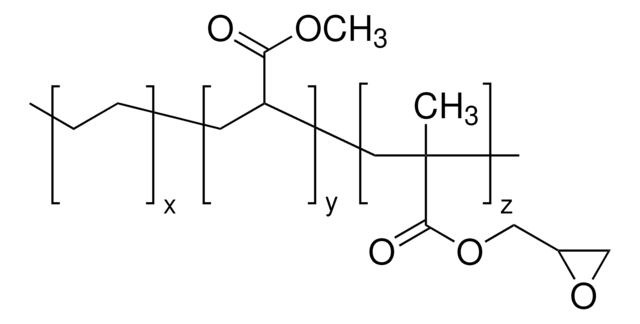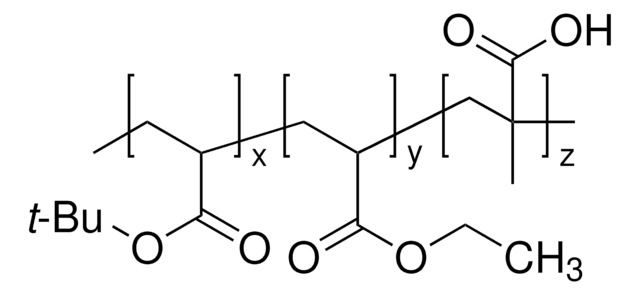463183
Poly(methyl methacrylate-co-ethylene glycol dimethacrylate)
50 μm particle size
Sign Into View Organizational & Contract Pricing
All Photos(2)
About This Item
Linear Formula:
[-CH2C(CH3)(CO2CH3)-]X[CH2(C-)(CH3)CO2CH2CH2O2C(C-)(CH3)CH2-]Y
CAS Number:
MDL number:
UNSPSC Code:
12162002
PubChem Substance ID:
NACRES:
NA.23
Recommended Products
form
particles (spherical)
crosslinking
5 % cross-linked
particle size
50 μm
density
1.19 g/mL at 25 °C (lit.)
SMILES string
COC(=O)C(C)=C.CC(=C)C(=O)OCCOC(=O)C(C)=C
InChI
1S/C10H14O4.C5H8O2/c1-7(2)9(11)13-5-6-14-10(12)8(3)4;1-4(2)5(6)7-3/h1,3,5-6H2,2,4H3;1H2,2-3H3
InChI key
XBDAKYZJVVYINU-UHFFFAOYSA-N
Looking for similar products? Visit Product Comparison Guide
Related Categories
General description
Particles of this polymer can be prepared by dispersion polymerization.
Application
Light diffusing agent in plastics, matting agent, anti-blocking agent and pore-forming agent in ceramics.
Poly(methyl methacrylate-co-ethylene glycol dimethacrylate) may be used as an extraction media coupled to gas chromatography with electron-capture detection (GC-ECD) to investigate remnants of six polychlorinated biphenyls (PCBs) in water samples.
Storage Class Code
11 - Combustible Solids
WGK
WGK 3
Flash Point(F)
Not applicable
Flash Point(C)
Not applicable
Personal Protective Equipment
dust mask type N95 (US), Eyeshields, Gloves
Choose from one of the most recent versions:
Already Own This Product?
Find documentation for the products that you have recently purchased in the Document Library.
Novel polymer monolith microextraction using a poly-(methyl methacrylate-co-ethylene dimethacrylate) monolith and its application to the determination of polychlorinated biphenyls in water samples.
Liu L, et al.
Chemosphere, 83(10), 1307-1312 (2011)
Gregory L Polyzois et al.
The International journal of prosthodontics, 15(6), 535-538 (2002-12-12)
The aim of this study was to evaluate the interfacial bond strength between different types of silicone facial elastomers and denture resins. The facial materials studied were Cosmesil and Ideal, whereas SR 3/60, SR 3/60 Quick, and Triad were included
S Sadamori et al.
Australian dental journal, 40(5), 322-326 (1995-10-01)
The dimensional changes of relined denture bases were evaluated in a laboratory study. Heat-cured resin, two autopolymerizing resins, microwave-activated resin and a new visible light-cured resin were used as relining materials in this study. The gaps between the metal die
Alcibiades Zissis et al.
The European journal of prosthodontics and restorative dentistry, 16(2), 81-84 (2008-07-22)
The aim of this long term study was to investigate the release of residual monomer from different denture materials, throughout a 38 months time period after curing and storage in water Specimens made of four denture base resins (three heat
S Salim et al.
The Journal of prosthetic dentistry, 67(6), 879-881 (1992-06-01)
The dimensional accuracy of rectangular acrylic resin specimens was examined when they were processed by three methods: a conventional method, the SR-Ivocap system, and a microwave curing method. The dimensional accuracy was evaluated by the change of the distance vector
Our team of scientists has experience in all areas of research including Life Science, Material Science, Chemical Synthesis, Chromatography, Analytical and many others.
Contact Technical Service







